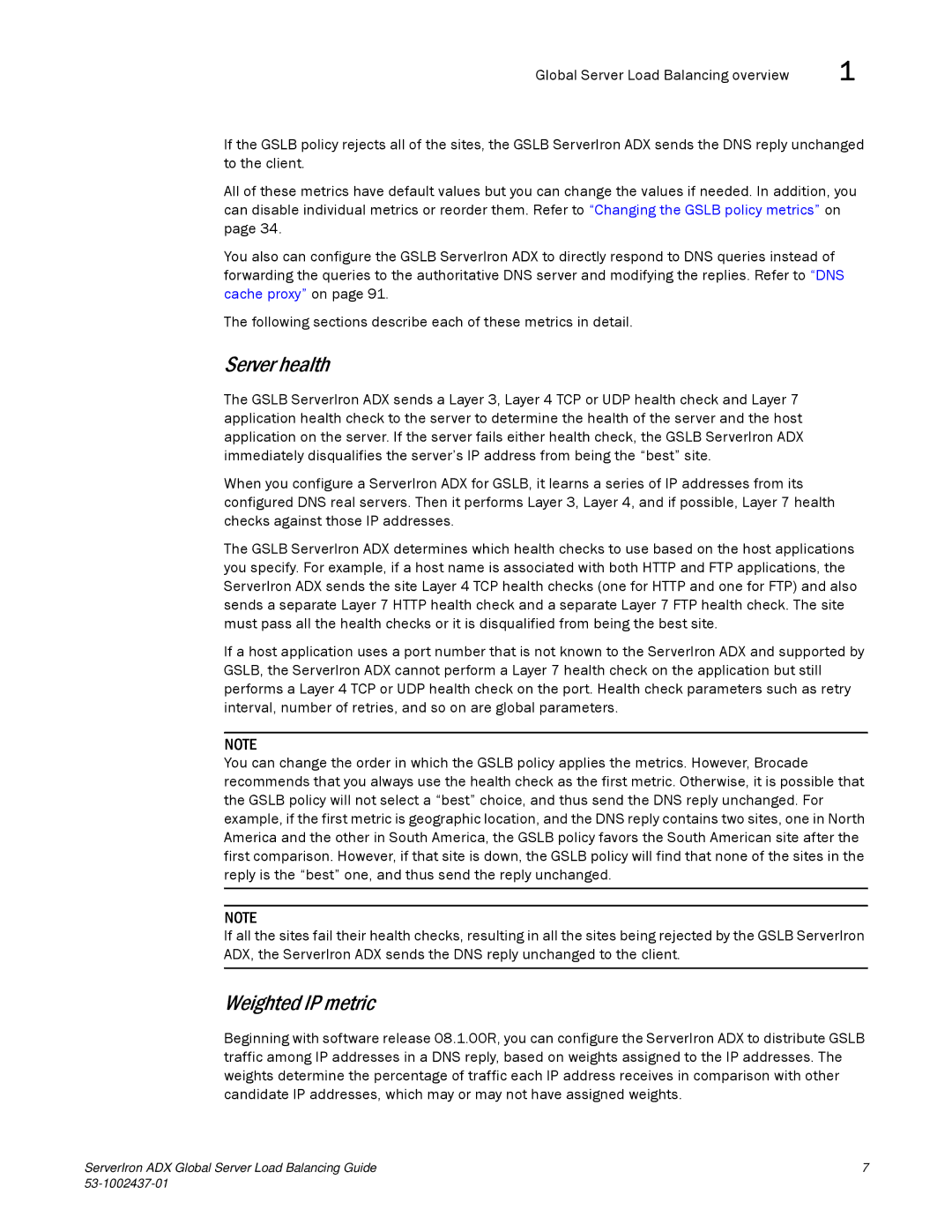
Global Server Load Balancing overview | 1 |
If the GSLB policy rejects all of the sites, the GSLB ServerIron ADX sends the DNS reply unchanged to the client.
All of these metrics have default values but you can change the values if needed. In addition, you can disable individual metrics or reorder them. Refer to “Changing the GSLB policy metrics” on page 34.
You also can configure the GSLB ServerIron ADX to directly respond to DNS queries instead of forwarding the queries to the authoritative DNS server and modifying the replies. Refer to “DNS cache proxy” on page 91.
The following sections describe each of these metrics in detail.
Server health
The GSLB ServerIron ADX sends a Layer 3, Layer 4 TCP or UDP health check and Layer 7 application health check to the server to determine the health of the server and the host application on the server. If the server fails either health check, the GSLB ServerIron ADX immediately disqualifies the server’s IP address from being the “best” site.
When you configure a ServerIron ADX for GSLB, it learns a series of IP addresses from its configured DNS real servers. Then it performs Layer 3, Layer 4, and if possible, Layer 7 health checks against those IP addresses.
The GSLB ServerIron ADX determines which health checks to use based on the host applications you specify. For example, if a host name is associated with both HTTP and FTP applications, the ServerIron ADX sends the site Layer 4 TCP health checks (one for HTTP and one for FTP) and also sends a separate Layer 7 HTTP health check and a separate Layer 7 FTP health check. The site must pass all the health checks or it is disqualified from being the best site.
If a host application uses a port number that is not known to the ServerIron ADX and supported by GSLB, the ServerIron ADX cannot perform a Layer 7 health check on the application but still performs a Layer 4 TCP or UDP health check on the port. Health check parameters such as retry interval, number of retries, and so on are global parameters.
NOTE
You can change the order in which the GSLB policy applies the metrics. However, Brocade recommends that you always use the health check as the first metric. Otherwise, it is possible that the GSLB policy will not select a “best” choice, and thus send the DNS reply unchanged. For example, if the first metric is geographic location, and the DNS reply contains two sites, one in North America and the other in South America, the GSLB policy favors the South American site after the first comparison. However, if that site is down, the GSLB policy will find that none of the sites in the reply is the “best” one, and thus send the reply unchanged.
NOTE
If all the sites fail their health checks, resulting in all the sites being rejected by the GSLB ServerIron ADX, the ServerIron ADX sends the DNS reply unchanged to the client.
Weighted IP metric
Beginning with software release 08.1.00R, you can configure the ServerIron ADX to distribute GSLB traffic among IP addresses in a DNS reply, based on weights assigned to the IP addresses. The weights determine the percentage of traffic each IP address receives in comparison with other candidate IP addresses, which may or may not have assigned weights.
ServerIron ADX Global Server Load Balancing Guide | 7 |
|
